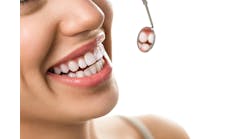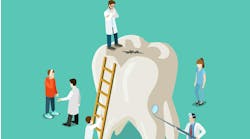by Mary Govoni, CDA, RDA, RDH, MBA
There is no doubt that the cost of infection control or prevention protocols, equipment, and supplies eats away at the bottom line in dental practices. Dentists don't have the ability, as in some other health-care settings, to charge a separate fee for supplies. Therefore, this cost is either included in the fees for services or it adds to the overhead, thus decreasing profitability.
There are many strategies that dental teams can implement to help reduce this cost, such as scheduling more treatment per appointment for patients, thus reducing the number of appointments needed to complete treatment. Working with dental supply companies to obtain the best pricing on equipment and supplies is another strategy. Reusing disposable items, however appealing it may be, is not a good strategy.
The types of disposable supplies that are frequently reused (inappropriately) are items such as suction tips, prophy cups and brushes, air/water syringe tips, and burs. Many times these items are placed in an ultrasonic cleaner to remove debris and then placed in a high-level disinfectant/sterilant, commonly referred to as the "cold sterile." These items can be very difficult to clean, especially burs and air/water syringe tips. If the items are not free of debris, they cannot be adequately disinfected or sterilized. These items can then pose a risk of cross-infection when used on a subsequent patient.
Items that are labeled as disposable are meant for one-time, one-patient use. The Food and Drug Administration (FDA) defines these types of devices as single-use devices or SUDs and has expressed concern regarding the reuse of these devices as a cost-saving measure. A little-known fact regarding the reuse of single-use items is that the FDA requires health-care facilities to ensure that a reprocessed single-use device is "as safe and effective as it was when originally manufactured." Health-care facilities are required by the FDA to meet the same manufacturing standards as used by the original manufacturer. This isn't possible in a dental practice or other facility, and reuse of these types of items carries with it a little-understood liability to the practice if a disease transmission takes place.
Burs and diamonds can be particularly difficult to clean, therefore increasing the risk of cross-infection. Hand-scrubbing of these items may be the most effective means of removing debris; however, it poses a greater risk of spatter exposure or puncture injuries to the team members who are performing this function. And although burs should be heat-sterilized in packages, they are frequently placed in chemical sterilants and stored in large bur blocks in the treatment rooms that are not packaged, and therefore potentially recontaminated prior to use.
Not only does the reuse of single-use items pose a risk of cross-infection, it can decrease efficiency in terms of the time spent in cleaning and disinfecting these difficult-to-clean items and the time necessary for chemical sterilization. Using new disposables each time, such as disposable burs, can actually increase efficiency and possibly comfort for the patient. Since the burs are always sharp and can cut tooth surfaces more quickly than reusable burs, a procedure can be completed in a shorter time.
There are many disposable bur choices available, both carbide and diamonds. Some examples of disposable burs and diamonds are Alpen x1 from Coltene/Whaledent, NeoBurr and NeoDiamond from Microcopy, Once from Midwest, and Tri Hawk. In addition, distributors such as Patterson Dental have their own branded disposable burs and diamonds.
I encourage all readers to reevaluate any practice that includes the reuse of disposable or single-use items. Be ever mindful of what is in the best interests of the patients we serve.
Mary Govoni, CDA, RDA, RDH, MBA, is the owner of Mary Govoni & Associates, a consulting company based in Michigan. She is a member of the Organization for Safety, Asepsis and Prevention. She can be contacted at [email protected] or www.marygovoni.com





